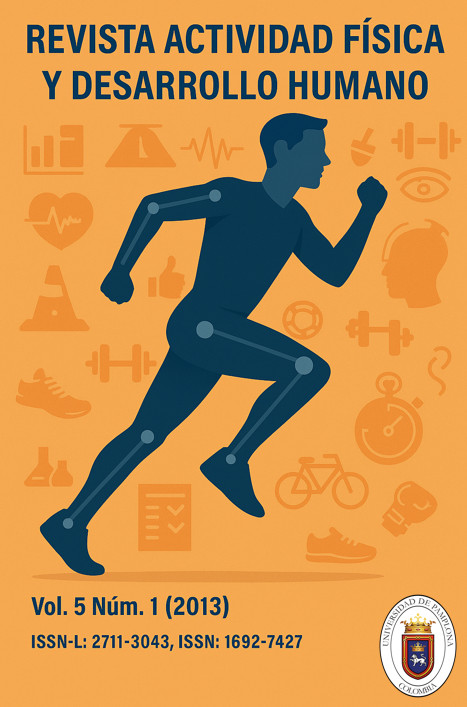Development of technique through the mini trampoline in hands-free exercises in women's artistic gymnastics
DOI:
https://doi.org/10.24054/afdh.v5i1.1701Keywords:
Programa, entrenamiento, gimnasiaAbstract
SUMMARY
The overall objective of this research project was to design a teaching strategy for developing technique through the use of mini trampolines in hands-free exercises in artistic gymnastics for girls at the Prometeo training school at the University of Pamplona. Throughout the history of artistic gymnastics, many authors have followed pedagogical criteria in their works to differentiate between different gymnastic movements. However, our foray into this subject has sought to highlight the idea of the emergence, evolution, diversification, and variety of trends within today's physical culture as a legacy of historical events in our field. The current eclectic nature of physical education in the education system brings together the different trends that have historically manifested themselves in each of the gymnastics systems. This research took a sample of 39 girls aged between 6 and 12 from different educational institutions and the University of Pamplona's gymnastics training school. The sample selected consisted of 10 girls aged between 9 and 12 from the gymnastics training school at the University of Pamplona. In this way, fundamental errors described in the problem description were corrected and reinforced in accordance with the pedagogical intervention that was carried out, where specific planning by microcycles was applied and, through specific tests and their correct descriptive and inferential statistical analysis, it was generally verified with results of p: 0.005, indicating the reliability of the proposed strategy, which should serve as a guide for the gymnastics departments at the University of Pamplona and for the training processes used by the Northern Santander Department League.
Downloads
References
BARTA PEREGORT, A. y DURAN, C. (1996): 1000 ejercicios de gimnasia rítmica deportiva. Editorial ESML. Madrid.
BIRKINA (1978) Gimnasia Rítmica Deportiva. Teoría y práctica. Barcelona: Paidotribo.
BLAZQUEZ, D. (1997): La evaluación en la Educación Física. Evaluación del proceso de enseñanza-aprendizaje. ICCEPS. Las Palmas.
CANALDA Llobet, A. (1995) Gimnasia Rítmica Deportiva. Teoría y práctica. Barcelona: Paidotribo.
ESTEVEZ Cullell y et al. La Investigación en la Actividad Física Su Metodología. Editorial Casa Popular. La Habana, Cuba, 2004
FERNÁNDEZ Del Valle, A. (1989). Fundamentos de la Gimnasia Rítmica. Madrid: Federación Española de Gimnasia. Madrid.
FERNÁNDEZ Del Valle, A. (1996). Gimnasia rítmica deportiva: aspectos y evolución. Madrid: Librerías deportivas Esteban Sanz, S.L.
LANGLADE, A. (1983). Teoría general de la Gimnasia. Buenos Aires: Ed. Stadium. Buenos Aires, 1983
Mendizabal, S.; Mendizabal, I. (1988). Gimnasia Rítmica. Aros, mazas y cintas. Madrid: Gymnos.
Real Decreto 1631/2006 por el que se establecen las enseñanzas mínimas correspondientes a la educación secundaria obligatoria.
SÁNCHEZ Lucena (1994) La evaluación en la Educación Física. Evaluación del proceso de enseñanza-aprendizaje. ICCEPS. Las Palmas
VERNETTA, M. (1995). Efecto Diferencial de Tres Estrategias en la Práctica para el Aprendizaje de Habilidades Gimnásticas. Tesis Doctoral. Facultad de Ciencias de la Actividad Física y del deporte. Universidad de Granada.
VERNETTA y LÓPEZ-BEDOYA (1997). Entrenamiento Combinado en el aprendizaje de las habilidades gimnásticas. I Encuentro sobre Investigación Deportiva. IAD. Málaga.
VERNETTA, M. (1997). Proyecto Docente. Fundamentos de las Habilidades Gimnásticas. Documento no Publicado. Departamento de Educación Física y Deportiva. Facultad de Ciencias de la Actividad Física y del Deporte. Universidad de Granada.
VERNETTA y LÓPEZ-BEDOYA (1998). Análisis de diferentes categorías del Feedback en dos formas organizativas del medio gimnástico. Motricidad. Vol IV, 113-130.
VERNETTA, M., LÓPEZ BEDOYA, J. y PANADERO, F. (Comp.) (1998). Novedades en Actividades Gimnásticas. Actas del III Simposium Nacional de Actividades Gimnásticas. Facultad de Ciencias de la Actividad Física y del Deporte. Universidad de Granada.
VERNETTA, M.; GUTIÉRREZ y LÓPEZ BEDOYA (2001). Aprendizaje de las Habilidades Gimnásticas de Aerobic. VI Simposium Nacional de Actividades Gimnásticas. INEF de Barcelona.
WENDT, H.; Hess, R. (1979). Gimnasia Rítmica Deportiva con aparatos manuales. Buenos Aires: Stadium
Downloads
Published
Issue
Section
License
Copyright (c) 2013 ACTIVIDAD FÍSICA Y DESARROLLO HUMANO

This work is licensed under a Creative Commons Attribution-NonCommercial-NoDerivatives 4.0 International License.











